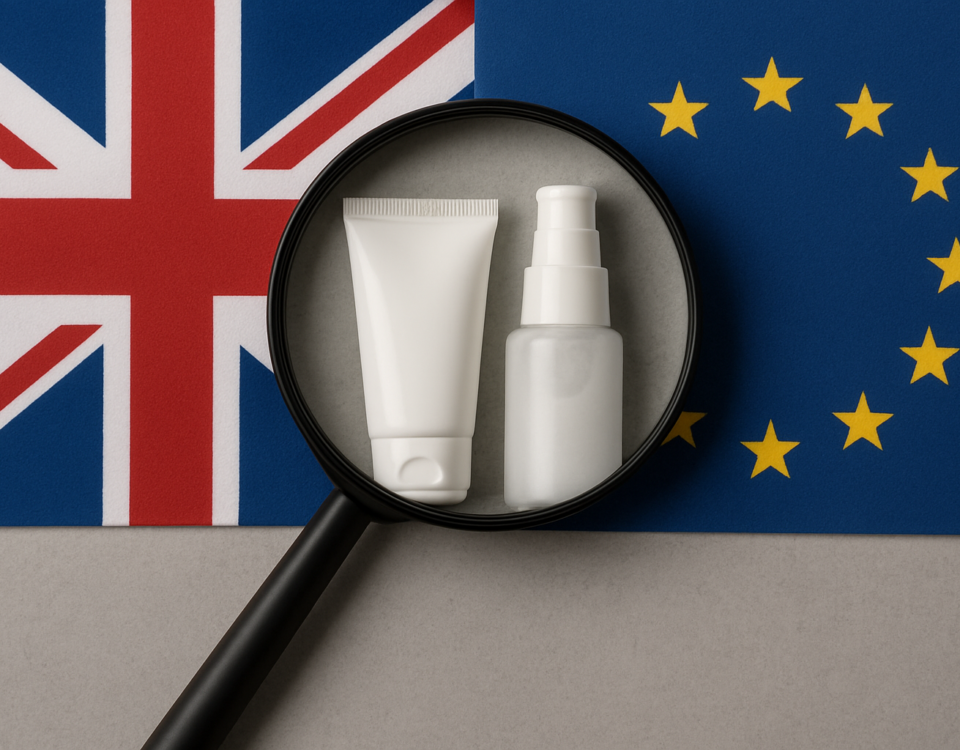
Organic or Natural cosmetics
6 May 2020
Octocrylene: the new “cat among the pigeons” of the cosmetics industry
23 April 2021The labeling of a cosmetic product is a means of communicating essential information to the consumer when purchasing it, but it is also a tool used by cosmetic marketing teams to promote the product on the market.
European cosmetic regulations impose mandatory information to appear on the labeling of cosmetic products (containers and packaging). These terms are listed in Article 19 of Regulation (EC) No. 1223/2009. They must be in indelible characters, easily legible and visible to the consumer.
These labeling obligations apply to all EU member states. Depending on the country, all or part of the labeling must be translated into the language of the country where the product is imported.
Name or company name and address of the responsible person (PR):
The PR is a natural or legal person based in the EU who guarantees, for each cosmetic product placed on the market, compliance with the European cosmetic regulation.
In the event that several addresses in the EU are indicated, the address where the PR makes available the product information file (PID) must be highlighted (by underlining it for example).
Brexit: To place a cosmetic product on the UK market from January 1, 2021, it will be imperative to indicate a responsible person domiciled in UK.
Native country :
The country of origin of cosmetic products imported into the EU must be indicated.
Nominal content:
The nominal content is expressed in units of mass or volume, this may not be mentioned for:
- products of less than 5 g or 5ml,
- free samples,
- single-use products.
The date of minimum durability (DMD) and the period after opening (PAO):
If the product has a DDM less than or equal to 30 months, it must be mentioned in the format MM / YYYY or MM / YY or DD / MM / YY. The date itself or the indication of where it appears on the packaging is preceded by the symbol “hourglass logo” or the words “to be used before the end”.
If the finished product has a DMD greater than 30 months: The indication of the DDM is not mandatory. However, the PAO must be indicated. It is usually expressed in months and is announced by the symbol “open jar”.
DTP is not mandatory in the following cases:
- single-use products,
- products that do not open (Ex: aerosols),
- products that do not present a risk of degradation (eg a perfume).
Special precautions for use and warnings *:
They inform the user of the measures to be taken in order to use the product safely. This is at least the information indicated in appendices III to VI of Regulation (EC) n ° 1223/2009 but also that found in the various recommendations of the European Commission or they are the warnings recommended by the assessor. of security.
The batch number:
It allows the identification of the cosmetic product. It is essential for the traceability of finished products on the market in the context of cosmetovigilance in particular.
Product function
The function of the product must be clearly indicated to avoid any misuse unless this is evident from the presentation of the product.
The list of ingredients *
The list of ingredients is followed by the words “INGREDIENTS” and is established in descending order of the weight of the ingredients with the exception of ingredients whose concentration is less than 1%, which may be mentioned in the wrong order. . The common name of the ingredients known as INCI is used.
This list may appear on the packaging only.
* If this is impractical, these information may appear on a notice, label, strip, card attached or attached to the product and must be associated with the “open book” logo.
What if we were talking about sorting …
In France, the presence of the Green Dot on packaging has not been mandatory since January 2017. However, in 2019, it remains mandatory in 3 countries: Republic of Cyprus, Spain and Greece.
Environmental notices:
In addition to the mandatory regulatory notices described in Regulation (EC) n ° 1223/2009, cosmetic products must also display environmental notices:
- The Green Dot logo: indicates that the company selling the product makes a contribution to a national sorting and recycling organization. This is no longer mandatory in France since January 1, 2017. However, in 2019, it remains mandatory in Spain, Greece and Cyprus.
- The Triman logo: is a French obligation that concerns all everyday consumer products and falling under extended producer responsibility (EPR).
From January 1, 2022, the display of the Triman logo will be mandatory on all packaging, whether recyclable or not.
The Triman commitment must systematically be associated with a sorting instruction.




